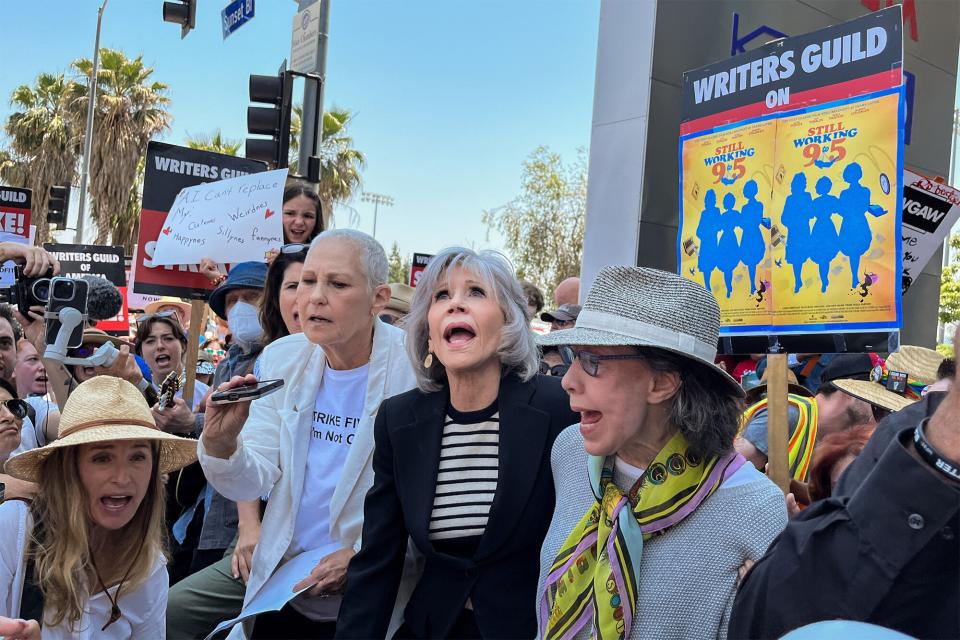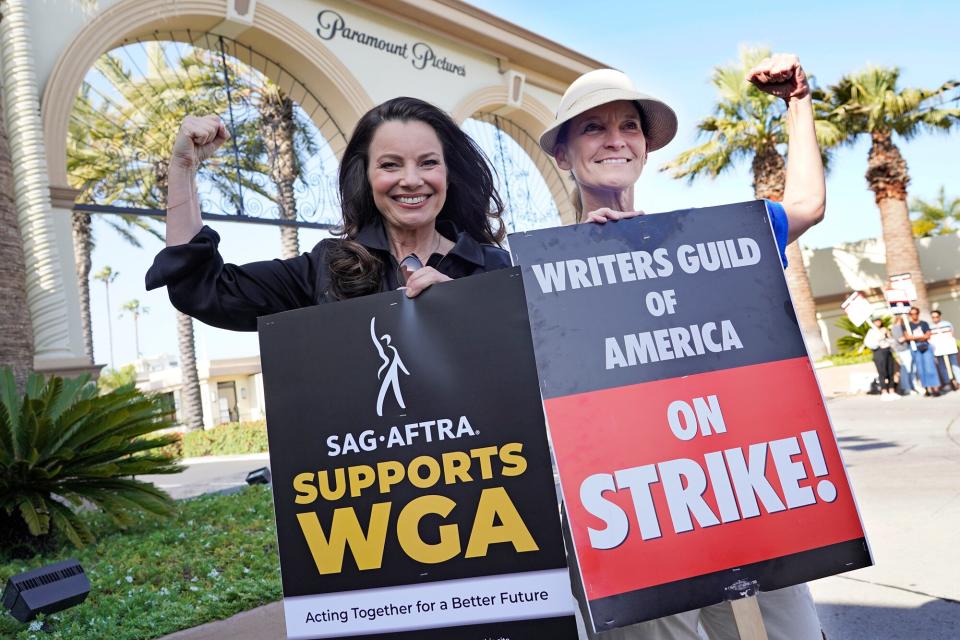SAG strike explained: How an actors' strike will impact TV and movies
- Oops!Something went wrong.Please try again later.
The first dual SAG and WGA strike since 1960 is on the horizon.
The Writers' Guild of America has been on strike since May after the Alliance of Motion Pictures and Television Producers rejected many of their proposed contract terms. Now, their fellow creatives, the actors, may take to the picket line (more formally) alongside them. The current SAG contract was set to expire on June 30, but at the last minute they extended the negotiation period until July 12 — perhaps not surprising given the timing.
"Who wants to start a strike the Friday night of July 4 weekend?" Jonathan Handel, entertainment lawyer and labor law expert, quips to EW. "There's no one around to strike against. They're all with family or at home or on vacation or something."
Still, Handel believes a SAG strike is imminent, even with negotiations continuing past the deadline. Particularly after more than 1,000 actors, including the likes of Glenn Close, Meryl Streep, Pedro Pascal, and Joaquin Phoenix, signed a letter urging no compromise in their asks from the Alliance of Motion Pictures and Television Producers.
But if the actors' union does go on strike what will that mean for audiences? Will the next entry in the Marvel Cinematic Universe still hit theaters? How will this impact fall movie season? What about fall television? We've got some answers. Read on for more below.

Jay L. Clendenin / Los Angeles Times via Getty Images Jane Fonda and Lily Tomlin join members of the WGA on the picket line.
How big an impact will a SAG strike have on TV?
To be quite honest, not much. "We've already had the immediate impact," says Handel. Because the WGA has already been on strike for a few months, much of what a SAG strike could grind to a halt has already been a casualty of the slowdown. In general, production has already been halted, either because scripts are not written yet or because WGA picketers have prevented International Alliance of Theatrical Stage Employees (IATSE) members from crossing picket lines, which led to set shutdowns.
Late night shows have already gone dark since May, so a SAG strike won't change what you're seeing on television in the immediate sense. There are potentially a handful of shows that are still in post-production that won't be complete without ADR or additional work from actors. But if those exist, there are likely only a few. "Most shows are either completed or they're not shot at all," says Handel. "The presence or absence of the SAG strike, doesn't have a huge additional effect, except that it probably puts more wind in the writers' sails and helps maintain solidarity."
"We've already seen the shows postponed going back to television," Handel adds. "We've seen several canceled. We probably are going to see fewer scripted series, even after this settles, at least for a certain time period."
Okay, but could happen to soap operas, talk shows, and reality television?
Though broadcasters, talk show hosts, soap opera performers, and yes, even some reality stars are members of SAG-AFTRA, they operate on a different contract that doesn't expire until next year. So, your daytime soaps and favorite unscripted television series are in the clear for now.
Where does streaming fit in?
SAG and WGA talent are very much behind the content, movies, and television, we see on streaming platforms. But much has been made of streamers potential "stockpiles," enabling them to hold out longer in a strike than studios or networks who are seeing their Fall TV schedules decimated and reduced to purely reruns or unscripted content. No one really knows how much of a backlog streamers like Netflix, Hulu, or AppleTV+ have banked, but it's likely that each platform is in a different position.
Still, this is creating a unique roadblock in reaching a deal in that many of the contract issues at play (streaming residuals, mini-rooms, etc.) are the direct result of the rise of streaming. But at the same time, if audiences aren't getting new content on network television, they might further turn to the offerings on streaming. In short, a longer strike could benefit some platforms like Netflix in a roundabout way. "The fact that it's harder to get the companies all on the same page makes it harder to get a deal done," explains Handel, "Because there are some divergent incentives and divergent business models."
What will happen to movies during a SAG strike?
A lot of big picture titles have already postponed their release dates because of production shutdowns and other fallout from the failure of the Alliance of Motion Pictures and Television Producers to come to the table. Nearly Marvel's entire slate was pushed back, including Captain America: Brave New World, Thunderbolts, Blade, Avengers: The Kang Dynasty, and Avengers: Secret World. Disney also delayed its live-action Moana movie, an untitled Star Wars film, and all of the Avatar sequels on future release calendars.
These projects could be pushed back further if a SAG strike occurs (particularly if it's a lengthy one). Handel says the only films that could continue production in the event of a SAG strike would be those that are truly independent, i.e. ones that have zero connection to a major studio or streaming platform. That means no distribution deal, no pick-up deal, and no financing from traditional avenues within the industry.
At any rate, because there's such a long lead time on production for films, it's likely audiences won't notice an impact until next year, if at all. "We've already started to see movies being shuffled around," explains Handel. "The studios are hoping that there won't be extended bare spots where there's nothing to see in the theaters. With the preexisting writers' strike, we're already in a slowdown period."

Chris Pizzello/AP Photo Fran Drescher, left, president of SAG-AFTRA, and Meredith Stiehm, president of Writers Guild of America West, during a rally by striking writers on May 8, 2023
What does this actually mean for actors and writers?
Regardless of how much audiences notice a difference on their end, a SAG strike would mark a historic moment in Hollywood. SAG and WGA have not been concurrently on strike since 1960.
That fight was largely over residuals from movies that played on television. "There had been a fight going on since 1948 by the guilds in an effort to secure residuals when a theatrical movie was played on TV," explains Handel. The 1960 strike secured those residuals for actors, writers, directors, and even some crew members. The strike also won the WGA and SAG new health insurance and pension plans.
"That cemented the concept of residuals into the system," says Handel. "Virtually every above-the-line Hollywood strike, since the inception of the unions, has been primarily about residuals, not about basic wages or benefits or rollbacks or what have you."
Handel notes that while residuals are part of the fight this time around, both SAG and WGA are concerned with other issues, particularly staffing writers' rooms and the use of AI. As with the rise of television in 1960, the strike(s) is once again predicated on the unforeseen impact of new technology on creatives.
"Whether you're talking about home video or basic cable or pay cable like HBO or internet, with the new technology, you're always operating under conditions of fear, uncertainty and doubt," says Handel. "Because you don't know what the cost structure is going to be and how that's going to evolve. You don't know what the market reaction is going to be and what the revenue is going to look like and how profits are going to evolve. It's a very difficult negotiation to have. Cause you're always negotiating at the age of uncertainty."
How long would a SAG strike last?
It's impossible to say. The 1960 SAG strike lasted six weeks, a fraction of the 148 days that totaled the concurrent WGA strike. The longest SAG strike in history was in 2000 and it lasted six months. It was specifically for commercial actors over residuals for television and radio ads.
Sign up for Entertainment Weekly's free daily newsletter to get breaking news, exclusive first looks, recaps, reviews, interviews with your favorite stars, and more.
Related content:

